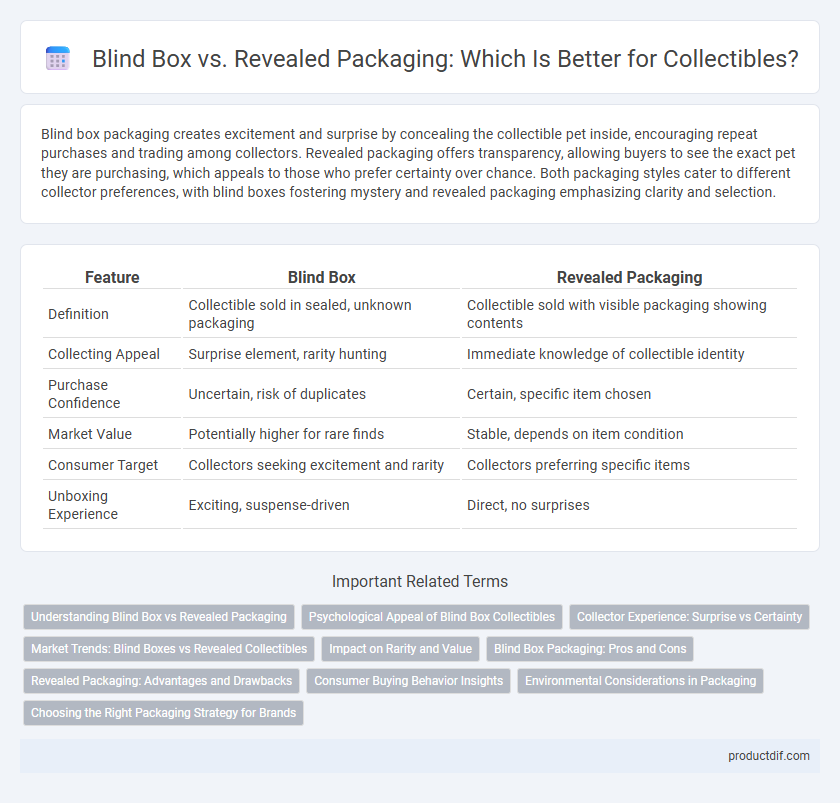Blind box packaging creates excitement and surprise by concealing the collectible pet inside, encouraging repeat purchases and trading among collectors. Revealed packaging offers transparency, allowing buyers to see the exact pet they are purchasing, which appeals to those who prefer certainty over chance. Both packaging styles cater to different collector preferences, with blind boxes fostering mystery and revealed packaging emphasizing clarity and selection.
Table of Comparison
| Feature | Blind Box | Revealed Packaging |
|---|---|---|
| Definition | Collectible sold in sealed, unknown packaging | Collectible sold with visible packaging showing contents |
| Collecting Appeal | Surprise element, rarity hunting | Immediate knowledge of collectible identity |
| Purchase Confidence | Uncertain, risk of duplicates | Certain, specific item chosen |
| Market Value | Potentially higher for rare finds | Stable, depends on item condition |
| Consumer Target | Collectors seeking excitement and rarity | Collectors preferring specific items |
| Unboxing Experience | Exciting, suspense-driven | Direct, no surprises |
Understanding Blind Box vs Revealed Packaging
Blind box packaging creates excitement by keeping the collectible a mystery until opened, enhancing the thrill of discovery and trading rarity among collectors. Revealed packaging allows buyers to see the exact item, providing certainty and immediate satisfaction without the gamble. Collectors often weigh the surprise element of blind boxes against the transparent assurance of revealed packaging based on their collecting goals and risk tolerance.
Psychological Appeal of Blind Box Collectibles
Blind box collectibles capitalize on the thrill of uncertainty and surprise, triggering dopamine release and enhancing the emotional reward of acquiring rare items. Collectors experience heightened anticipation and curiosity, which strengthens brand loyalty and repeat purchases. This psychological appeal contrasts with revealed packaging, where the absence of mystery reduces excitement and the perceived value of the collectible.
Collector Experience: Surprise vs Certainty
Blind box packaging offers collectors the thrill of surprise, enhancing the excitement through unpredictability and rarity discovery. Revealed packaging provides certainty, allowing collectors to make informed choices and avoid duplicates in their collections. Both approaches cater to different collector preferences, balancing excitement and control in the collectible market.
Market Trends: Blind Boxes vs Revealed Collectibles
Blind boxes dominate the collectible market by leveraging the thrill of surprise and rarity, driving higher consumer engagement and repeat purchases. Revealed packaging appeals to collectors seeking transparency and certainty, often commanding premium prices for known limited editions. Market data shows blind box sales growth outpaces traditional revealed collectibles, fueled by trends in gamification and social media unboxing experiences.
Impact on Rarity and Value
Blind box packaging increases the rarity by introducing an element of surprise, making certain collectibles harder to obtain and therefore more valuable among collectors. Revealed packaging allows buyers to select specific items, reducing uncertainty but often lowering the potential market value due to easier availability. Collectors tend to assign higher worth to blind box items because scarcity driven by unknown distribution enhances desirability and secondary market demand.
Blind Box Packaging: Pros and Cons
Blind box packaging enhances the thrill of collecting by introducing an element of surprise, thereby increasing consumer engagement and repeat purchases. However, this format may lead to frustration due to potential duplicates and uncertainty about the contents, impacting collector satisfaction. While blind boxes drive sales through excitement and rarity, they can complicate inventory management and affect secondary market values.
Revealed Packaging: Advantages and Drawbacks
Revealed packaging offers collectors the advantage of immediately identifying the item, reducing the risk of duplicates and enabling informed purchases based on personal preferences. This transparency enhances trust and satisfaction while potentially increasing resale value due to verified authenticity. However, revealed packaging may decrease the excitement and surprise element that blind boxes provide, possibly limiting impulse buying and reducing appeal for collectors who enjoy the thrill of chance.
Consumer Buying Behavior Insights
Consumers gravitate towards blind box packaging for the thrill of surprise and the potential rarity of collectibles, which drives repeat purchases and enhances perceived value. Revealed packaging appeals to buyers seeking certainty and specific items, reducing purchase hesitation and improving satisfaction with the acquisition. Understanding these preferences helps brands tailor marketing strategies to match consumer psychology and maximize sales in the collectible market.
Environmental Considerations in Packaging
Blind boxes generate significant packaging waste due to their opaque design, which encourages repeated purchases without product visibility, leading to overconsumption. Revealed packaging reduces waste by allowing consumers to see the collectible before buying, minimizing impulse purchases and returns. Sustainable materials and minimalistic design in both packaging types are essential to lower environmental impact in the collectible market.
Choosing the Right Packaging Strategy for Brands
Brands selecting packaging strategies must weigh consumer engagement and market trends when choosing between blind box and revealed packaging. Blind box packaging drives excitement and repeat purchases through the allure of surprise and rarity, while revealed packaging builds trust and informs buyers by showcasing the product upfront. Effective decisions hinge on target demographics, product type, and long-term brand goals to optimize sales and customer loyalty.
blind box vs revealed packaging Infographic

 productdif.com
productdif.com